Tracing the Lewalf path across the South Downs into Lewes, Fred Garratt-Stanley shines a light on the innovative, community-centred work being done at one of the world’s most progressive non-League football clubs, East Sussex-based Lewes FC
Just before the hilltop trail curves past Lewes Golf Club and plunges down steeply into the county town of East Sussex, you catch a glimpse of The Dripping Pan in the distance. At first, this peculiarly-named football ground may not seem like the most striking landmark on the horizon. But, in recent years, its local and national significance has surged dramatically.
With the excessive wealth and commercialism of the Premier League alienating increasing numbers of fans, the importance of non-league football to the UK’s rich sporting culture is becoming increasingly clear. However, the lower echelons of the game continue to be disregarded and underfunded. When that happens, we miss out on some incredibly inspiring community stories.
“As a club, we’re performing for our community by speaking out and holding the football industry to account for the ugly side of the game, and hopefully showing a more beautiful way forward”
Tucked between the slopes of the South Downs is a football club that embodies the spirit of community more than most. One hundred percent fan-owned ever since the club transitioned into a supporter ownership model in 2010, Lewes Community Football Club is firmly committed to pursuing equality and solidarity in sport.
“As a club, we’re performing for our community by speaking out and holding the football industry to account for the ugly side of the game, and hopefully showing a more beautiful way forward,” says Kelly Lindsey, the club’s Head of Performance. That agenda is reflected in various progressive policies; in 2017, they launched their Equality FC initiative, becoming the first football club in the world to equalise playing budgets and resources for men’s and women’s teams. They’ve campaigned for the banning of gambling ads in football, and regularly fundraise for local food banks and other community projects. To date, over 2500 fans have bought membership packages, under a one-fan, one-vote system.
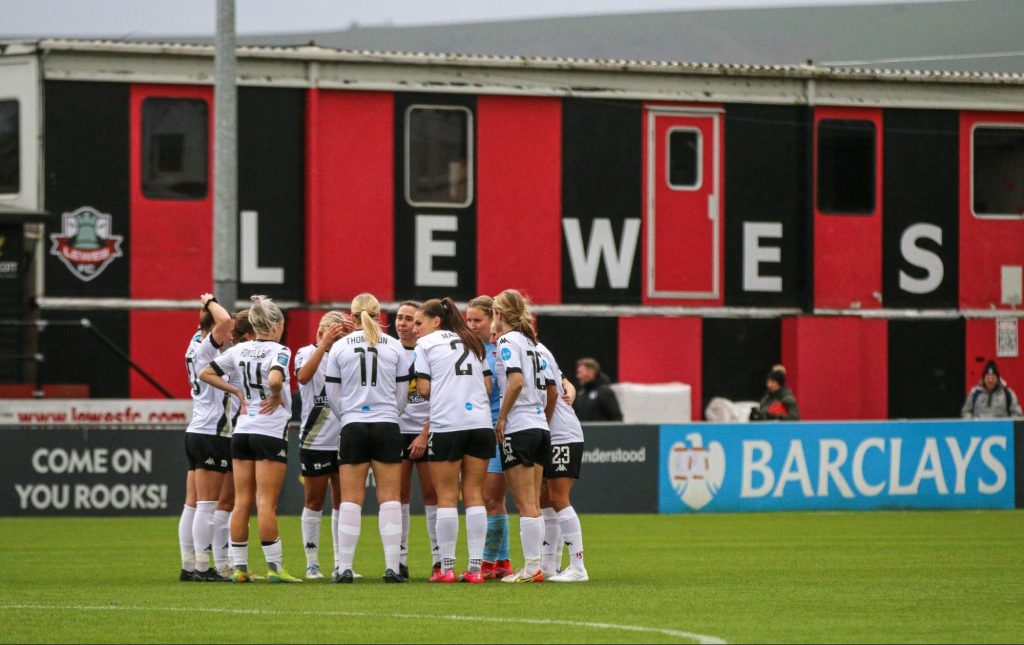
Lewes FC also happens to be situated in one of British football’s most scenic spots. The name of East Sussex’s historic county town reputedly comes from the Old English word lǣw (meaning ‘incision’), a reference to its location where the River Ouse cuts through the Downs. Here, the Slow Ways route Lewalf two links Lewes to the small village of Alfriston, around 10 miles away. It’s a beautiful trail that connects some of the area’s most picturesque settlements. On Non League Day, a nationwide event dedicated to celebrating England’s unique football pyramid, I decided to make this path my journey to the match.
Lewes FC also happens to be situated in one of British football’s most scenic spots […] It’s a beautiful trail that connects some of the area’s most picturesque settlements
This story will follow Lewalf two backward from Alfriston to Lewes, using this historic route to explore an area of the country where football’s power for good is being utilised to the full. Tracing a journey towards The Dripping Pan, where Lewes have played since their formation in 1885, I’ll explore the work the club is doing in the local community by speaking to staff members and fans with a real stake in this innovative organisation. Ultimately, I’ll be looking to the future, and asking this question: how can we learn from Lewes FC’s pioneering approach to football?
Friday, 24th March
My train rushed at speed between the provincial towns and housing estates of Surrey and Sussex, and the quiet green gaps in between. Out of the window, the blurred outlines of aimlessly wandering horses gave way, incongruously, to the blank industrial structures of Gatwick Airport’s railway station, before we zoomed back into the country. As we rolled into Lewes, dappled sunlight shone across the pages of my notebook. On the left, a raised embankment parallel to the tracks offered space for runners and walkers, while clusters of houses on the right indicated our arrival in the town.
I was visiting for the day to speak to some people who have cemented Lewes’ reputation as a club focused on “Football for good“. Turning left out of the station, I strolled towards The Dripping Pan, just two minutes away. The pitch was being readied for Saturday’s men’s match against Potters Bar Town, and a few other staff members were milling around, but mostly it was quiet.
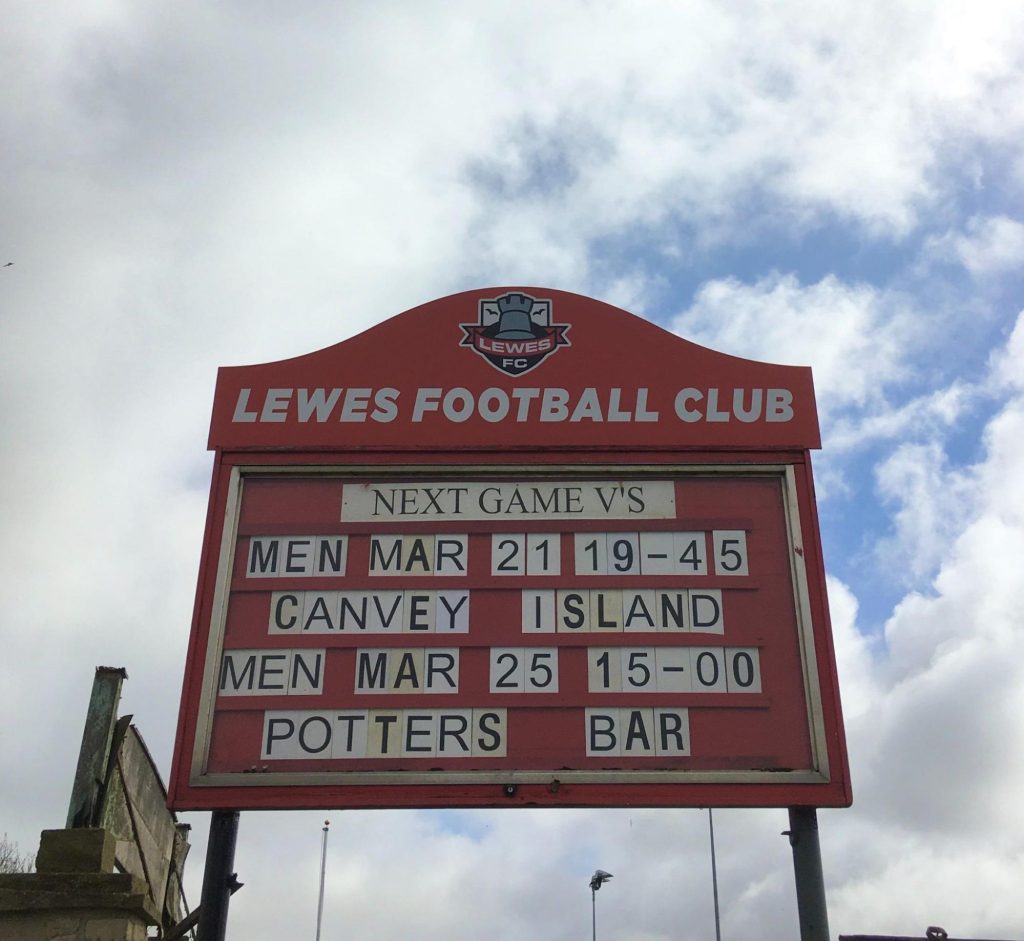
I strolled down into the empty Rook Inn, the Pan’s main bar, and was soon met by Lewes FC’s Fan and Community Engagement Officer, Shrey Nilvarna. After making us both a hot drink, he explained what his role entails.
“The club is based on the community’s grounds, so it’s important to have that connect,” he says. “It’s trying to build that bridge between the club and the town and trying to get people interested in football, not just for football, but for the other things that go along with it.” As well as building the club’s image and brand, he’s responsible for listening to fans’ concerns, making sure things run smoothly on matchdays, and organising wider community-oriented schemes, such as food bank and charity collections. Given all that work, it’s hardly surprising to hear Shrey say that since he joined the club in September 2021, the connection with the local area has improved. A big part of that comes down to Lewes’ fan ownership model.
No other team in the UK matches Lewes’ commitment to the women’s game
“I’m an elected Director, in a volunteer role,” says Trevor Wells, a key fan representative and board member at the club who joins us in the Rook Inn after a short while. “We get elected by the owners of the club. As a board, we decide the direction of the club, the budgets, the campaign work we do, and then we’ve got brilliant staff who carry all those things out for us.”
“I’m just a guardian of the club for the owners. We’ve got 2500-ish owners now, and you’re a guardian for their interests, so it’s important that everything we do is transparent.” Underlining that emphasis on transparency, Lewes decided in 2021 to start publishing their annual Club Strategy online, aiming to increase accountability and collaboration between clubs. As Kelly Lindsey tells me over a video call following my visit, “the secret to high performance is being transparent, and collaborative, and open,” with women’s football in particular shaped by the notion that “We’re developing the game together.” But while clubs are constantly learning from each other, no other team in the UK matches Lewes’ commitment to the women’s game.
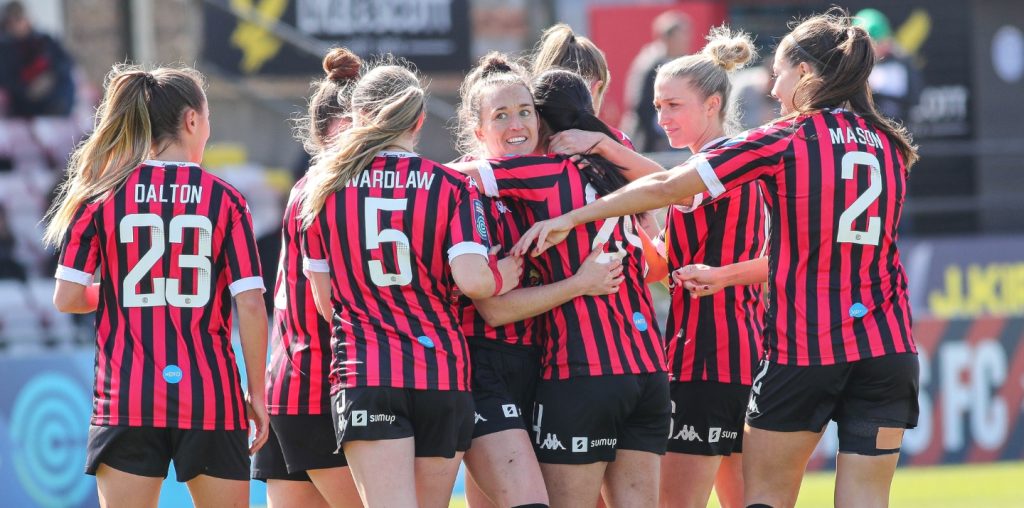
Lewes Women celebrate a goal (Photo Credit: James Boyes)
“Plenty of girls and women want to play football… why should they be treated differently?” says Trevor. “We started by giving both our first teams the same budgets, giving them the same resources in terms of club support. It costs the same to watch both teams, because we don’t think that women’s football should be devalued — it’s all equal.”
The impact of this drive for equality has been seriously impressive. Investment in the women’s team has improved standards, with Lewes Women now competing in the Championship, English football’s second tier (for context, the Men’s side play in the Isthmian League Premier Division, the seventh tier). A few days before I visit the club, the women’s team lined up against Manchester United in the quarter-finals of the FA Cup, a testament to how far they’ve come. And they’re not the only ones to have benefited from the move.
“The standard of football is getting better on both sides, the facilities are getting better, the matchday experiences are getting better, the crowds are getting better,” says Trevor. “Our turnover has gone up. We’ve got more sponsors coming in, and they haven’t come by accident, they’ve come because they’ve heard about what we’re doing, and they like it.”
But the club’s progressive agenda can only be truly effective if it’s matched by high performance. “We’re trying to build a club that’s on the road to becoming completely professional,” says Shrey. “It’s important for people to realise that non league football is still football of a high standard.” For Kelly, high performance is best achieved by a holistic approach, “being person-centred and telling people to be their authentic self, individualising every plan and programme… really trying to build a culture of trust and vulnerability.” And while professionalism is the goal, it’s also crucial that the community-centred non-league essence of the club isn’t lost. According to Shrey, Non League Day plays a key role in showing people that.
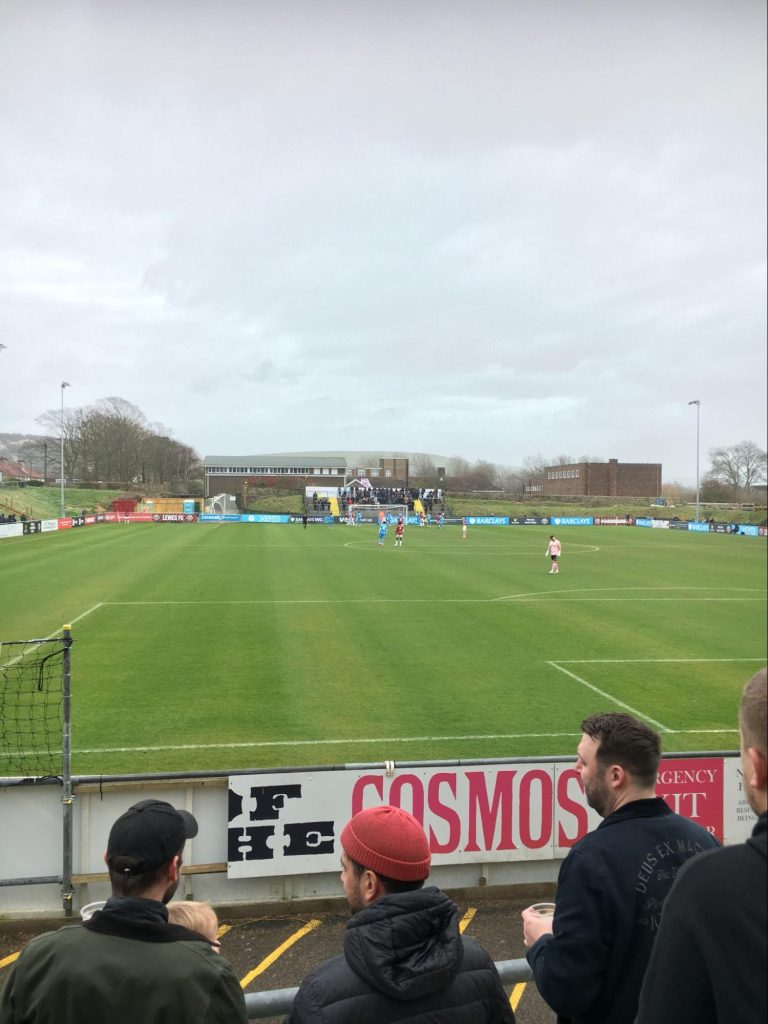
“You’ve got good quality football, at a reasonable price, you can have a good afternoon out, have a pint, have a pie, be with your friends,” he says. “All of the culture, the different vibes of the town, you can see in a non-league game. You get to feel that, and connect with local people who come in who you probably wouldn’t interact with on a normal day.” As someone who has spent a lot of time watching non-league football, it’s these values that keep me coming back.
After my conversation with Shrey and Trevor, I wandered back through town. I popped into the local brewery’s John Harvey Tavern on my way, taking in its charming dark wood panelling, stone floors, and friendly middle-aged chatter before jumping on the train to Brighton, where I was staying for the night. Passing through the smooth slopes of the Downs, I looked forward to spending a day traversing this beautiful part of the UK countryside.
Saturday, 25th March
“If we’re having a good time, I want other people to have a good time — it’s all about sharing these experiences,” says Stan Lahood, hardcore Lewes supporter and founder of fan page Lewes Clamour. A few days before visiting Lewes, I spoke to him about how his group of friends (labelled the ‘Youth Wing’) have helped grow the bond between club and fanbase and “enhance the community aspect” by attending away matches and chatting to fans, board members, and directors alike.
It was an overcast day, and the wind whipped against us as the road cut through quiet fields, with the Downs rising and falling on either side of the old coach’s trail
“Once you become an owner, it’s a commitment. It makes you feel more involved,” he adds. As Non League Day arrived, and I got out bright and early for the Alfriston to Lewes walk — joined by my girlfriend and her family, Brighton locals — I anticipated seeing this community togetherness in action.
After a half-hour drive, we parked up in Alfriston, a small, sleepy village filled with pretty old red brick houses, one of which (Alfriston Clergy House) was the first property to be bought by the National Trust, back in 1896. After ascending West Street, we joined the Old Coach Road, a medieval path linking the village to Lewes which we’d follow for most of the morning. It was an overcast day, and the wind whipped against us as the road cut through quiet fields, with the Downs rising and falling on either side of the old coach’s trail.

Before long, the town of Lewes came into view and brought the prospect of the day’s sporting action into focus
Along this stretch, it felt secluded, with barely a soul other than the odd mud-caked mountain biker roaring past. Any sense of wildness was ramped up by the strong winds battering us (which would’ve been even worse up on the exposed hill path to our left), and the path’s course brought to mind old characters that would’ve passed along this trail — farmers, families, merchants. The past was clinging onto the village of Firle, too, which we passed through five miles into the journey, with its farmer’s barns, twee village shop, and picturesque country pub. Unfortunately, a less romantic section of the walk followed, as we crossed the A27 (traffic-lighted, mercifully) before rolling into Glynde.
Two miles east of Lewes, the village of Glynde sits on the flank of Mount Caburn, providing the walk’s steepest incline. At the top, we had a gorgeous view over the Downs, and before long, the town of Lewes came into view and brought the prospect of the day’s sporting action into focus. The football club play an important role in shaping the town’s identity — as Kelly says, “It’s really important that clubs like us exist and fight the good fight,” — so experiencing Lewes through the prism of ‘the Rooks’ seemed to make total sense.
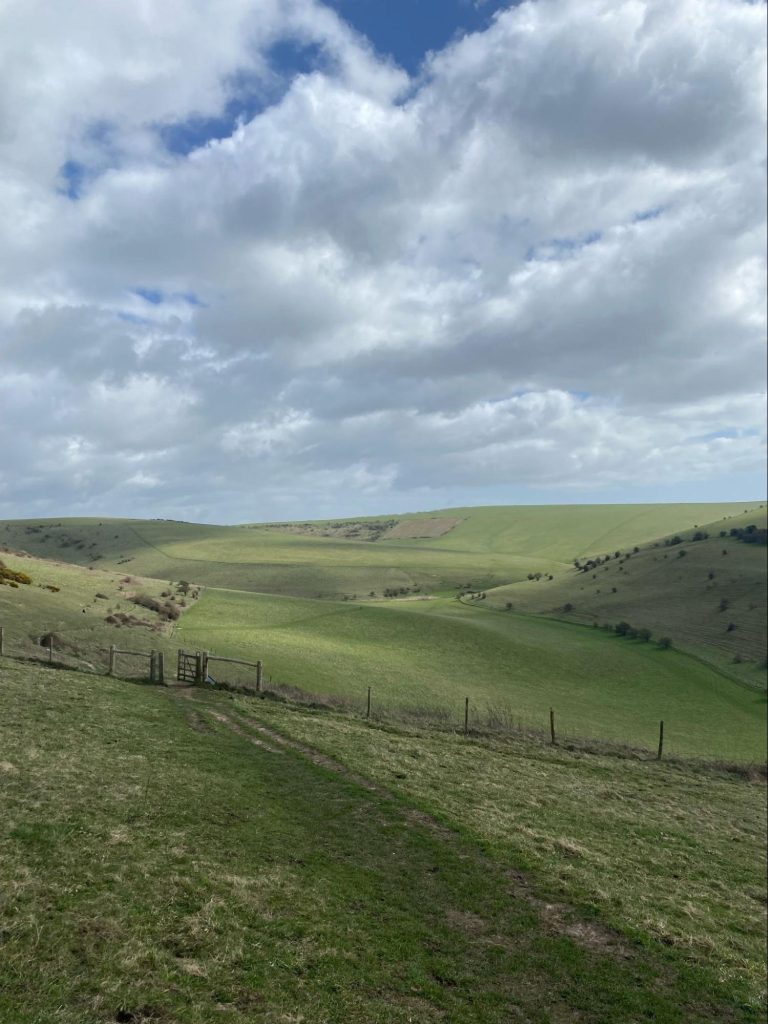
After arriving in Lewes (meeting some friends on the final stretch toward the town), we rested up at the Snowdrop Inn, a quirkily decorated pub a few minutes from the high street. We fueled up on local beer and pub grub, and as kick-off neared, began making our way out toward The Dripping Pan.
Well-known across the non-league spectrum, it’s a ground full of character, with a main stand that buzzes and crackles on matchdays, a great food selection including pie, mash, and gravy or loaded fries, and stunning views over the South Downs. Those features, combined with the general friendliness of the place – “we aim to build a safe matchday experience… for everyone,” says Shrey – make The Dripping Pan a popular spot for neutrals and opposition fans, with Mike Bayly’s excellent 2020 book British Football’s Greatest Grounds voting it the best in the UK.
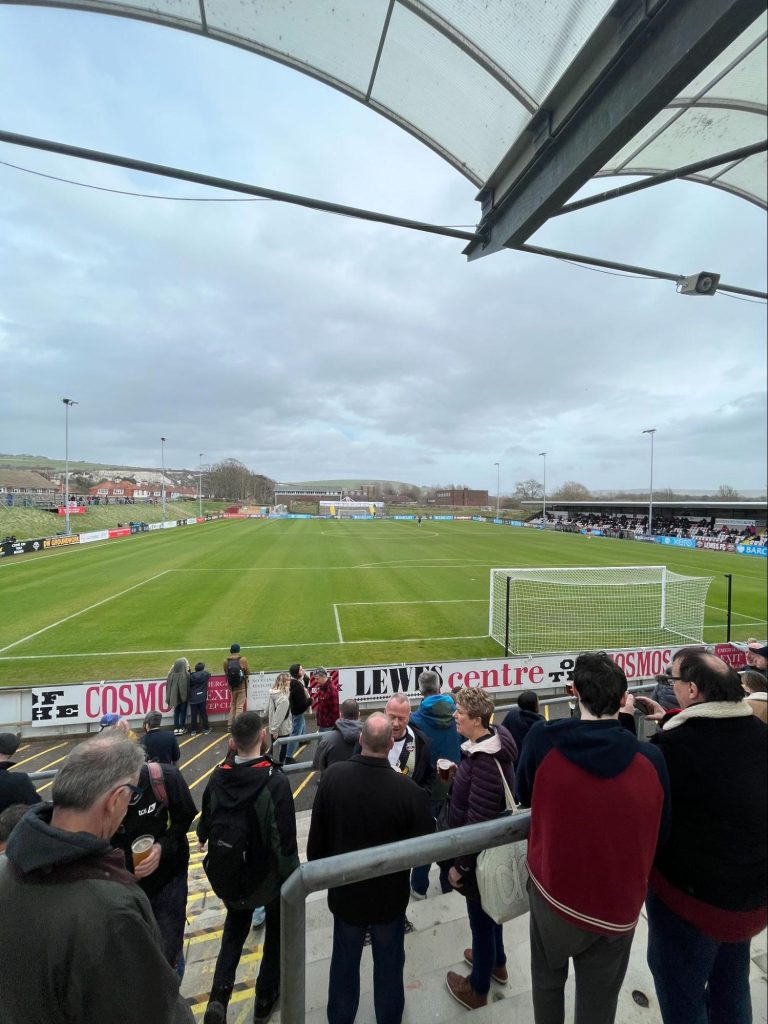
The game itself played out unsurprisingly; play-off-chasing Lewes grabbed an opener after 30 minutes, before talismanic No. 9 Joe Taylor doubled the lead and shifted the home side into cruise control against their mid-table opponents. There was a late consolation for Potters Bar, but Lewes won 2-1, and the post-match scenes on the pitch — as players were joined by their young families to applaud the home fans — highlighted the bond that’s been fostered between them. That being said, the crowd’s volume suffered slightly from the unlucky absence of a few key members of the ‘Youth Wing’. According to Stan, “Because we bring atmosphere to the games, we’ve developed a good relationship with the club,” and losing this core group on Non League Day understandably had an impact on the noise levels.
“You’ve got to keep fans and community at the centre of what you do, because they are the ones who keep us all on the pitch”
However, that doesn’t change the fact that local people are connecting with Lewes FC like never before. Whether it’s young girls inspired by the appearance of England superstars like Alessia Russo or Ella Toone at their local ground, students sucked in by the hedonism and community pride harnessed by non-league football, or Brighton-supporting pensioners priced out of supporting a Premier League team, there’s a place at Lewes for everyone. “You’ve got to keep fans and community at the centre of what you do, because they are the ones who keep us all on the pitch,” says Kelly Lindsey. It’s a message that the country’s richer clubs could do with paying attention to — at the Dripping Pan, it’s one that won’t be forgotten anytime soon.
To become a Lewes FC owner, head to the club’s website to find out more.
“Tales from a Slow Way” winner, Fred Garratt-Stanley is a freelance football and culture writer published in GQ, Vice, Huck, NME, and more. Based in South London, he is a huge non-league football fan and regularly attends lower league matches across the capital and further afield, documenting those trips on his blog, Stanchion.